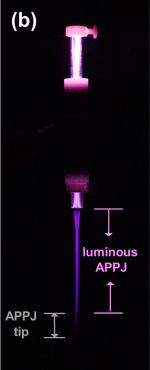EPJ D Highlight - Plasma tool for destroying cancer cells
- Details
- Published on 11 March 2014

Inducing biological tissue damage with an atmospheric pressure plasma source could open the door to many applications in medicine
Plasma medicine is a new and rapidly developing area of medical technology. Specifically, understanding the interaction of so-called atmospheric pressure plasma jets with biological tissues could help use them in medical practice. Under the supervision of Sylwia Ptasinska from the University of Notre Dame, in Indiana, USA, Xu Han and colleagues conducted a quantitative and qualitative study of the different types of DNA damage induced by atmospheric pressure plasma exposure, in a paper published in EPJ D as part of a special issue on nanoscale insights into Ion Beam Cancer Therapy. This approach, they hope, could ultimately lead to devising alternative tools for cancer therapy as well as applications in hospital hygiene, dental care, skin diseases, antifungal care, chronic wounds and cosmetics treatments.
To investigate the DNA damage from so-called non-thermal Atmospheric Pressure Plasma Jet (APPJ), the team adopted a common technique used in biochemistry, called agarose gel electrophoresis. They studied the nature and level of DNA damage by plasma species, so-called reactive radicals, under two different conditions of the helium plasma source with different parameters of electric pulses.
They also identified the effect of water on DNA damage. To do so, they examined the role of reactive radicals involved in DNA damage processes occurring in an aqueous environment. They then compared them to previous results obtained in dry DNA samples.
The next step would involve investigating plasma made from helium mixtures with different molecular ratios of other gases, such as oxygen, nitrous oxide, carbon dioxide and steam, under different plasma source conditions. The addition of another gas is expected to increase the level of radical species, such as reactive oxygen species and reactive nitrogen species, known to produce severe DNA damage. These could, ultimately, help to destroy cancerous tumour cells.
Plasmid DNA damage induced by induced by Helium Atmospheric Pressure Plasma Jet, X.Han, W. A. Cantrell, E. E. Escobar and S. Ptasinska (2014), European Physical Journal D, DOI 10.1140/epjd/e2014-40753-y





